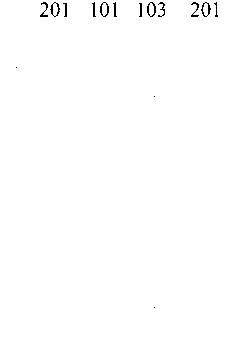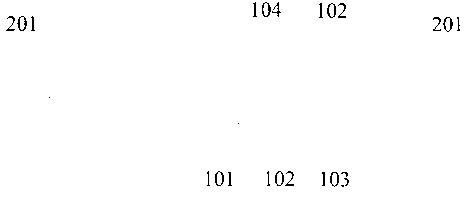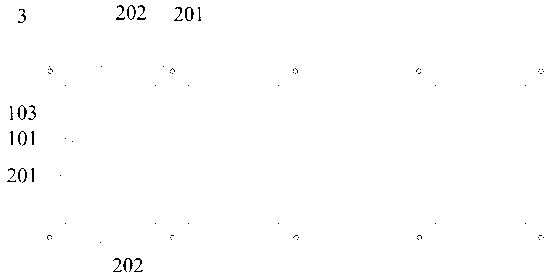Flexible solar battery component and packaging method thereof
A technology of solar cells and encapsulation methods, applied in the field of solar photovoltaics, can solve problems such as loss of lightness, increase in weight of flexible battery components, inability to realize modular expansion of high-power battery components, etc., and achieve the effect of good flexibility
- Summary
- Abstract
- Description
- Claims
- Application Information
AI Technical Summary
Problems solved by technology
Method used
Image
Examples
Embodiment 1
[0033] See Figure 1 to Figure 3 , the structure of the flexible solar cell module is: weather-resistant polymer material front plate 101 (ie, the outer packaging layer) + adhesive film 102 + flexible solar cell chip 103 + adhesive film 102 + weather-resistant polymer material back plate 104 (ie, the inner packaging layer) , the size of the front plate 101, the back plate 104, and the adhesive film 102 are consistent and ensure that the flexible solar cell chip 103 can be completely covered, and there is enough excess after covering, that is, the adhesive film completely covers the battery chip and is packaged around the battery chip A flexible insulating layer that can be hot-melt welded, and a part of the flexible insulating layer is placed between two layers of adhesive film and is tightly adhered to the adhesive film, and a part of the area protrudes from the edge of the battery component and is not bonded to the adhesive film. There is a certain distance between the flexi...
Embodiment 2
[0036] Packaging methods for flexible solar cell modules:
[0037]1. Cut the material according to the design size. When designing the size, the size of the front plate, the back plate and the adhesive film are the same and ensure that the solar cells can be completely covered, and there is enough excess after covering. The order from top to bottom is: front plate , adhesive film, flexible solar cell chip, adhesive film, and backplane are laminated according to the designed size; a flexible insulating layer is also laid around the solar cell chip, and a part of the flexible insulating layer is sandwiched between two layers of adhesive film. The distance between the edge of the battery chip and the flexible insulating layer is greater than 10 mm, usually 10 mm to 20 mm.
[0038] 2. After the lamination is completed, use a high temperature resistant vacuum bag for vacuum sealing.
[0039] 3. The sealed components are put on the movable support and enter the autoclave together f...
Embodiment 3
[0057] See Figure 7 with Figure 8 In this embodiment, the heat-melt weldable flexible insulating layer in the flexible solar cell module is made of a whole piece of thermoplastic polymer material, and the battery module is integrated by heat-melt welding of the thermoplastic polymer material around the battery chip. Thermoplastic polymer materials are embedded between the two layers of adhesive film used to wrap the battery chip. The structure of the flexible solar cell module is a polymer material front plate 101, an adhesive film 102, a flexible insulating layer that can be hot-melt welded, and a solar cell chip 103, an adhesive film 102, a polymer material back plate 104, and a flexible insulating layer that can be hot-melt welded. It is packaged on the same layer as the solar battery chip 103; and there is a certain distance between the battery chip and the flexible insulating layer, and the distance is preferably 20 mm. The front plate 101 and the back plate 104 are e...
PUM
 Login to View More
Login to View More Abstract
Description
Claims
Application Information
 Login to View More
Login to View More - R&D
- Intellectual Property
- Life Sciences
- Materials
- Tech Scout
- Unparalleled Data Quality
- Higher Quality Content
- 60% Fewer Hallucinations
Browse by: Latest US Patents, China's latest patents, Technical Efficacy Thesaurus, Application Domain, Technology Topic, Popular Technical Reports.
© 2025 PatSnap. All rights reserved.Legal|Privacy policy|Modern Slavery Act Transparency Statement|Sitemap|About US| Contact US: help@patsnap.com



